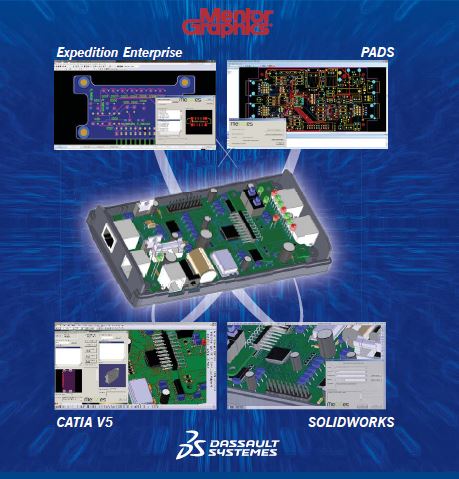MECODES EDMD Collaboration for CATIA V5

A solution by: CADCAM GROUP
Application domain: Product Life Cycle Management
Solution Overview
In conventional design approach using ECAD and MCAD authoring tools, electro-mechanical product are designed with many separate rework iterations in each tool. When the design is independently finished in each tool, the process continues to the common design phase where the MCAD and ECAD designers collaborate to produce the final electro-mechanical product. The mechatronic approach is quite different since there are no separate design phases in each of the authoring tools, instead there are many common rework iterations with no distinct boundaries between electrical and mechanical design. The nature of common rework iterations implies that real mechatronic collaboration must be integrated into the CAD tools to enable engineers to work across boundaries of their working domain. MECODES is introducing a new methodology for multidomain collaboration during the design of electromechanical products.

Benefits
The usual collaboration between CAD engineers is only by model exchange between the tools they are working in. MECODES made a step further where the model exchange is enhanced with features which make the collaboration much easier. The common process of design synchronization is guided and further enhanced that the data from the logical model is transferred correctly. Such synchronization allows the engineers to see detailed data from opposite domains which are used and are important for design. For example, electrical data is visible in a familiar way in the CATIA V5
or SolidWorks model tree and in the same way MCAD data is visible in ECAD. The environment is enhanced with supporting functions which help engineers to execute their tasks faster and more precise. Examples of such functions are: PIN swap function, footprint change, generation of Mechatronic BOM and others.
One of the central points in the MECODES collaboration suite is the common PCB library system. The PCB library has a management feature and the users can insert new components and modify them within the library. One of the most important features is the link between 3D component representation (MCAD) and electrical component representation (ECAD) which includes a schematic symbol for each component. The common library can store the transformation matrix which is controlling the component placement into the MCAD model; thereby reducing the risk of misplacement of components.
The MECODES environment relies on a floating license principle. In a networked collaboration environment with many working stations, the license is selected based on real customer usage, which means that the license is retrieved from the server when the client is using it, not before. In this way the client’s collaboration environment is using only as many licenses as they need. For example, the customer has bought 10 licenses and is using them in a network of 30 working statio
